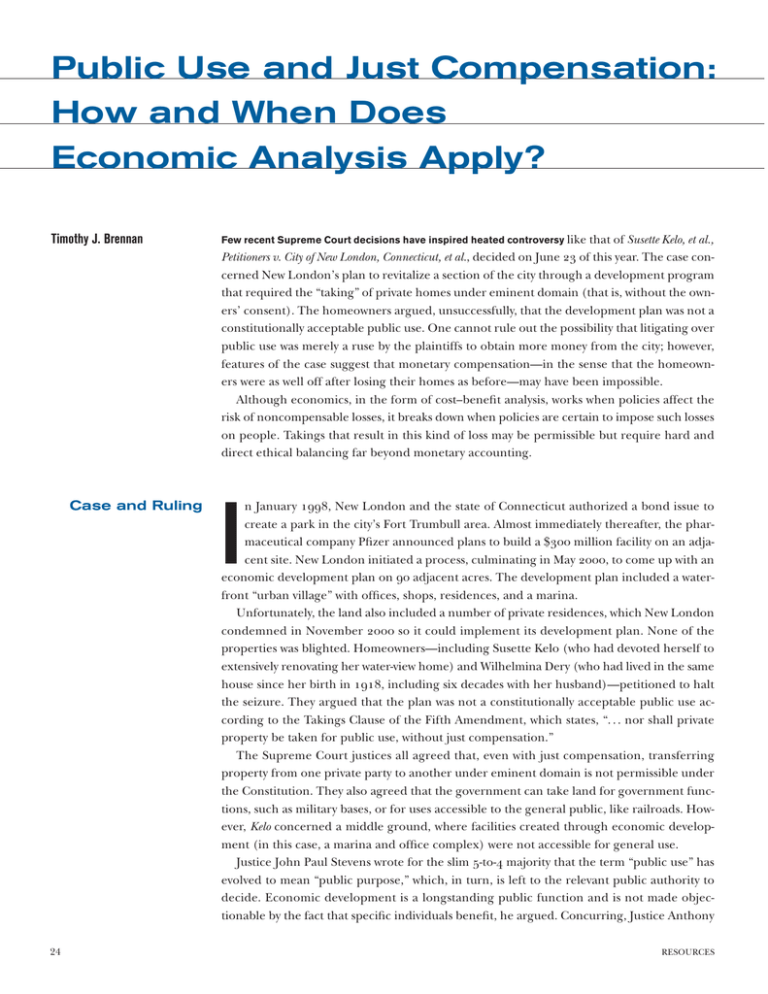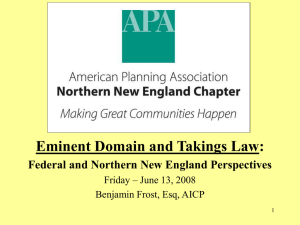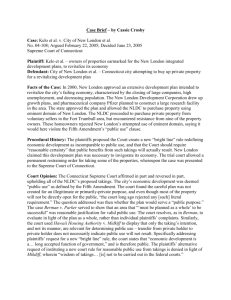Public Use and Just Compensation: How and When Does Economic Analysis Apply?
advertisement

Public Use and Just Compensation: How and When Does Economic Analysis Apply? Timothy J. Brennan Few recent Supreme Court decisions have inspired heated controversy like that of Susette Kelo, et al., Petitioners v. City of New London, Connecticut, et al., decided on June 23 of this year. The case concerned New London’s plan to revitalize a section of the city through a development program that required the “taking” of private homes under eminent domain (that is, without the owners’ consent). The homeowners argued, unsuccessfully, that the development plan was not a constitutionally acceptable public use. One cannot rule out the possibility that litigating over public use was merely a ruse by the plaintiffs to obtain more money from the city; however, features of the case suggest that monetary compensation—in the sense that the homeowners were as well off after losing their homes as before—may have been impossible. Although economics, in the form of cost–benefit analysis, works when policies affect the risk of noncompensable losses, it breaks down when policies are certain to impose such losses on people. Takings that result in this kind of loss may be permissible but require hard and direct ethical balancing far beyond monetary accounting. Case and Ruling 24 n January 1998, New London and the state of Connecticut authorized a bond issue to create a park in the city’s Fort Trumbull area. Almost immediately thereafter, the pharmaceutical company Pfizer announced plans to build a $300 million facility on an adjacent site. New London initiated a process, culminating in May 2000, to come up with an economic development plan on 90 adjacent acres. The development plan included a waterfront “urban village” with offices, shops, residences, and a marina. Unfortunately, the land also included a number of private residences, which New London condemned in November 2000 so it could implement its development plan. None of the properties was blighted. Homeowners—including Susette Kelo (who had devoted herself to extensively renovating her water-view home) and Wilhelmina Dery (who had lived in the same house since her birth in 1918, including six decades with her husband)—petitioned to halt the seizure. They argued that the plan was not a constitutionally acceptable public use according to the Takings Clause of the Fifth Amendment, which states, “. . . nor shall private property be taken for public use, without just compensation.” The Supreme Court justices all agreed that, even with just compensation, transferring property from one private party to another under eminent domain is not permissible under the Constitution. They also agreed that the government can take land for government functions, such as military bases, or for uses accessible to the general public, like railroads. However, Kelo concerned a middle ground, where facilities created through economic development (in this case, a marina and office complex) were not accessible for general use. Justice John Paul Stevens wrote for the slim 5-to-4 majority that the term “public use” has evolved to mean “public purpose,” which, in turn, is left to the relevant public authority to decide. Economic development is a longstanding public function and is not made objectionable by the fact that specific individuals benefit, he argued. Concurring, Justice Anthony I RESOURCES Kennedy added that some takings “might justify a more demanding standard” when favoritism of particular private parties is suspected. In a scathing dissent, Justice Sandra Day O’Connor stated that under the majority’s opinion, “the specter of condemnation hangs over all property. Nothing is to prevent the State from replacing any Motel 6 with a Ritz-Carlton, any home with a shopping mall, or any farm with a factory” and that the majority’s deference to local government makes the public use clause nothing more than “hortatory fluff.” Only a “stupid staff[er]” could fail to gin up a public purpose justification for any taking, because most property has some imaginable “more productive or attractive possible use.” Those lacking the political wherewithal to influence local governments are most vulnerable to having their property taken. Within a week, the House of Representatives passed a nonbinding resolution disagreeing with the majority, reserving its right to address “abuse of eminent domain” if executed by state and local governments for purposes that do not “serve the public good.” Agreeing with Justice O’Connor, Congress noted that the Kelo decision would put poor, minority, and elderly constituents at disproportionate risk. Both houses introduced bills to prevent the federal government from exercising eminent domain for economic development and to deny federal funds to state and local governments that did, and several state governments passed laws preventing takings like New London’s. ith respect to land use, habitat preservation, and other regulatory policies, economists have extensively examined when and how much compensation should be provided to private property owners in government takings. Some economic analyses suggest that government should pay for seized property to bear the costs of its actions (not only the direct loss to the property owner but also people’s reduced incentive to produce and trade if they believe that the government can arbitrarily take their property). However, the government is an actor directed by its constituents, including property owners, and so should already be taking the property owners’ interests into account. However, other analyses recognize that different constituent groups have different levels of influence and that opposition to otherwise efficient policies may be defused by compensating politically powerful groups. The crux of the Kelo case was not compensation per se but the kinds of use under which government takings are constitutionally permissible. Although purely private transfers are not allowable, economic principles alone do not rule them out. Sometimes the benefits to the winner exceed the costs to the loser. However, government is not needed for such transfers; transactions in which benefits exceed costs are already possible through voluntary exchange. In addition, government-engineered transfers suffer from both inadequate information (the government cannot know that one person values something more than someone else does) and undue political influence (a party may be able to get the government to take property on its behalf, no matter what its value to the original owner). For a taking to be justified on economic grounds, market exchange must somehow “fail,” but public use is neither a sufficient nor necessary condition for the failure. It is insufficient in that government cannot take property for its own purposes without the owner’s consent. When the government wants to procure equipment, lease office space, or hire workers, it normally is required to do so through the market. In and of itself, public use also is not necessary. The leading criterion for market failure in land use is the need for the simultaneous consent of many landowners. Building a highway requires obtaining land along a continuous path, and any landowner holdouts along the way could scuttle the project. Even if the value of the road exceeds the prior value of the land, negotiation may not succeed, because W FALL 2005 Why Compensate? Why Take? 25 each landowner has an incentive to hold out for an inordinately high price. The “many landowners” problem may affect not only government infrastructure (roads, parks, and military bases) but also large-scale, essentially private enterprises (railroads, pipelines, and sports stadiums). It may even be relevant to large multifunction enterprises, such as the waterfront complex envisioned by the New London Development Corporation. Even if the market fails for public or private uses, eminent domain could be erroneously applied or politically abused. In focusing exclusively on public use and neglecting potential market failure, the Supreme Court’s decision illustrated the limits to which economics can and perhaps should affect constitutional interpretation. Is Compensation the Real Issue? iven the weakness of the link between public use and the market failure to justify eminent domain, it could be argued that the petitioners’ focus on public use was but an indirect attempt to increase their compensation. Property owners would be expected to attempt to maximize their compensation, and New London may have wanted to pay owners below market value. However, even market value may not compensate for an incurred loss. A person typically buys something because it is worth more to him or her than the actual money paid. Accordingly, an economist defines compensation not by market value but by whether it makes the original property owners just as well off after the taking as before: can they purchase similar homes with compensation received and be just as happy as in the old homes? Exactly what constitutes “just as well off” is determined by each property owner—not the government, a court, or another outside party. If an owner has a strong emotional attachment to the property, then market value may never be enough compensation for its taking, and more money may not be the solution. The Kelo case raises the possibility that no monetary award could compensate these residents for the taking of their homes. Noncompensable losses are not unheard of; for example, no amount of money can bring a person back from the dead. Although many people would G the construction job. But if a study of people a similar risk reduction but at a the labor market reveals that the con- cost of more than $5 million—say, $10 struction job is filled when it is offered million—would give them a $50 benefit Imagine a group of people who can at $50/week more than the office job, worth less than the $100 per-person choose between two jobs: one in an one could infer that people who apply cost. Recent studies find SVOLs in the office or one on a construction site. for the construction job would pay at range of $5 million to $7 million. Working on the construction site entails most $50 to avoid a 1-in-100,000 a small added risk—say, a 1-in-100,000 chance of a fatality. If 100,000 people with severe difficulties in measurement chance of fatality in any given week. made this choice, each willing to pay no and interpretation, the overall principle That small risk excluded, people would more than $50 to avoid the marginally remains: if people are willing to spend be willing to work either job if salaries more risky job, then one could say that only a finite amount to reduce the risks were the same. collectively, the construction workers of losses beyond compensation, then a would pay no more than $5 million finite SVOL value can and should be slightly less desirable because of the (100,000 × $50) to avoid one expected used to determine whether the costs of added risk, it must pay more to attract fatality (100,000 × 1/100,000 chance). a policy are worth incurring. How to Calculate Incalculable Losses Because the construction job is workers. If people are unwilling to take 26 Although risk estimation is fraught That $5 million value is known as the risks at all, then no wage will be high statistical value of life (SVOL) in cost– enough to convince someone to take benefit studies. A policy that would give RESOURCES happily accept market value for their properties—especially if they could sell high—the petitioners in Kelo may have believed that no amount of money could compensate them for the losses of their homes. ost–benefit analyses assign monetary values to gains and losses to establish the theoretical possibility that the parties who gain from a policy (in the Kelo case, beneficiaries of New London’s development) could compensate the parties who lose (in this case, the homeowner petitioners). Such techniques are an important part of environmental policy, even when the policy’s effects include life-or-death matters, such as exposure to toxic pollutants. Does the Kelo decision indicate that cost–benefit analysis can never be applied when losses are beyond monetary compensation? Monetary benefits can be assigned to loss prevention not because all losses can be reduced to money values but because people typically sacrifice only finite amounts to reduce the chance of suffering such losses—even noncompensable ones (see sidebar, How to Calculate Incalculable Losses on page 26). For example, most people have limits on how much they are willing to spend on cars that offer multiple air bag protection. Some people accept the physical risk associated with a certain job because of an associated pay premium. And although I have no way of knowing, I would be surprised if Ms. Kelo and Ms. Dery never lit candles or used a fireplace or if they had installed automatic sprinkler systems to limit the risk of destruction of their irreplaceable homes. If a policy costs more to reduce risk than the beneficiaries themselves pay for such reductions, then the benefit is worth less than the expense. The beneficiaries would be better off with the money, and, from an economic perspective, the reduction in risk is not worth reducing. Moreover, nothing is logically inconsistent about an unwillingness to spend unlimited amounts to reduce risk, even when the loss itself is noncompensable. (Some people may find it irrational to refuse a huge sum of money in exchange for a property, but in economics, “rationality” refers only to logical consistency—not wisdom.) Beyond a certain level of compensation, the value diminishes; more money will never increase well-being enough to compensate for the loss. C Balancing Interests for Noncompensable Losses onetary cost–benefit analysis breaks down as we move from policies with small effects on the chance a noncompensable loss might occur to policies that are certain to cause losses. The parties who gain from a policy would not be unable to compensate the parties who lose. But the inapplicability of cost–benefit analysis does not mean that property should never be taken. Instead, conceptions of the public interest that extend beyond money (for example, increasing aggregate well-being or protecting moral rights) are needed to justify such policies. Consequently, the public use clause of the Fifth Amendment may reflect the need to recognize nonmonetary ethical norms when property is taken by the government. The clause does not address how to sort out efficient and inefficient interventions, but it can help ensure that the public sector restricts takings to settings in which the social values promoted are of sufficient moral import to justify inflicting harm on parties who could never fully recover. Economics cannot substitute for ethics when losses cannot be calculated in dollars and sense. ■ Public Use and Limits on Economics M The complete text of the Kelo decision is available at www.supremecourtus.gov/opinions/ 04pdf/04–108.pdf. FALL 2005 27




